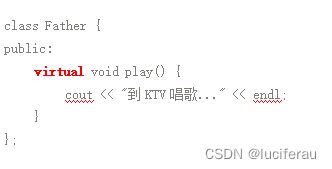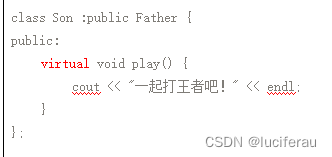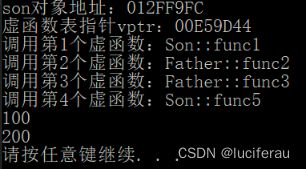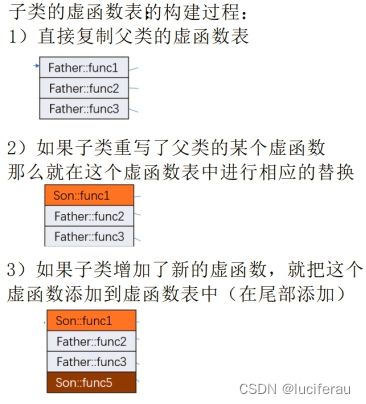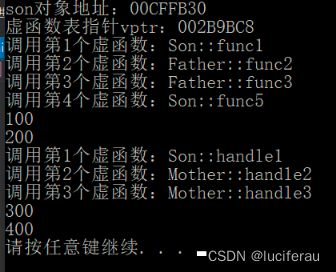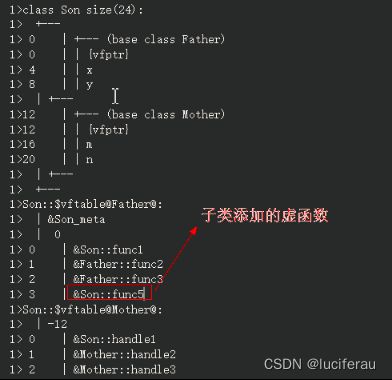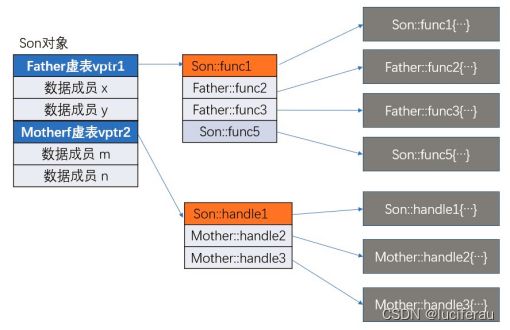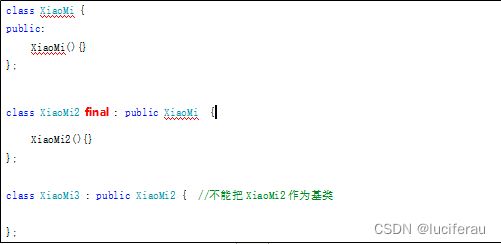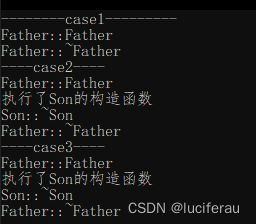c++一篇文章详解多态的使用
为什么要使用多态
项目需求:
因为各种不确定原因,包括人为原因,ODU设备会自动的切换到其它类型的设备,而切换后的设备,和原设备有很多不同的地方。如何完美的实现这个切换呢?
解决方案:
使用多态。
聚会案例:
Demo.cpp
#include 解决方案:
通过虚函数,实现多态。
项目多态-虚函数
多态的本质:
形式上,使用统一的父类指针做一般性处理,
但是实际执行时,这个指针可能指向子类对象,
形式上,原本调用父类的方法,但是实际上会调用子类的同名方法。
【注意】
程序执行时,父类指针指向父类对象,或子类对象时,在形式上是无法分辨的!
只有通过多态机制,才能执行真正对应的方法。
基础-虚函数的使用
虚函数的定义:
在函数的返回类型之前使用virtual
只在成员函数的声明中添加virtual, 在成员函数的实现中不要加virtual
虚函数的继承:
l 如果某个成员函数被声明为虚函数,那么它的子类【派生类】,以及子类的子类中,所继承的这个成员函数,也自动是虚函数。
l *如果在子类中重写这个虚函数,可以不用再写virtual, 但是仍建议写virtual, 更可读!*
虚函数表
单个类的虚函数表
#include VS的对象内存分布分析:
项目的命令行配置中添加: /d1 reportSingleClassLayoutFather
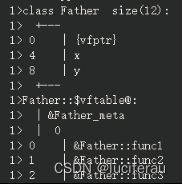
对象内,首先存储的是“虚函数表指针”,又称“虚表指针”。
然后再存储非静态数据成员。
对象的非虚函数,保存在类的代码中!
对象的内存,只存储虚函数表和数据成员
(类的静态数据成员,保存在数据区中,和对象是分开存储的)
添加虚函数后,对象的内存空间不变!仅虚函数表中添加条目
多个对象,共享同一个虚函数表!
使用继承的虚函数表
#include 多重继承的虚函数表
#include 内存分布
子类的虚函数表
- 直接复制父类的虚函数表
- 如果子类重写了父类的某个虚函数,那么就在这个虚函数表中进行相应替换
- 如果子类添加了新的虚函数,那么就把这个虚函数添加到虚函数表中(末尾添加)
final
用来修饰类,让该类不能被继承
理解:使得该类终结!
用来修饰类的虚函数,使得该虚函数在子类中,不能被重写
理解:使得该功能终结
class XiaoMi {
public:
virtual void func() final;
};
void XiaoMi::func() { //不需要再写final
cout << "XiaoMi::func" << endl;
}
class XiaoMi2 : public XiaoMi {
public:
void func() {}; // 错误!不能重写func函数
};
override
override仅能用于修饰虚函数。
作用:
-
提示程序的阅读者,这个函数是重写父类的功能。
2 .防止程序员在重写父类的函数时,把函数名写错
#include override只需在函数声明中使用,不需要在函数的实现中使用。
遗失的子类析构函数
#include 解决方案析构函数加上virtual关键字
把Father类的析构函数定义为virtual函数时,如果对Father类的指针使用delete操作时,就会对该指针使用动态析构(如果这个指针指向的时子类对象,那么先调用子类对象的析构函数,再调用Father类的(自己类)析构函数)
为了防止内存泄露,最好是在基类析构函数上添加virtual关键字,使基类析构函数为虚函数
目的在于,当使用delete释放基类指针时,会实现动态的析构:
如果基类指针指向的是基类对象,那么只调用基类的析构函数
如果基类指针指向的是子类对象,那么先调用子类的析构函数,再调用父类的析构函数
纯虚也有用:纯虚函数与抽象类
什么时候使用纯虚函数
某些类,在现实角度和项目实现角度,都不需要实例化(不需要创建它的对象),
这个类中定义的某些成员函数,只是为了提供一个形式上的接口,准备让子类来做具体的实现。
此时,这个方法,就可以定义为“纯虚函数”, 包含纯虚函数的类,就称为抽象类。
#include 纯虚函数的注意事项···
父类声明某纯虚函数后,那么它的子类。
1)要么实现这个纯虚函数 (最常见)
2)要么继续把这个纯虚函数声明为纯虚函数,这个子类也成为抽象类
3)要么不对这个纯虚函数做任何处理,等效于上一种情况(该方式不推荐)
项目实例
ODU.h
#pragma once
#include ODU.cpp
#include "ODU.h"
#include ODU335.h
#pragma once
#include "ODU.h"
class ODU335 :public ODU
{
public:
ODU335();
bool heartBeat()override;
//bool set()override;
};
ODU335.cpp
#include "ODU335.h"
ODU335::ODU335()
{
cout << "调用ODU335" << endl;
type = ODU_TYPE::ODU_TYPE_335;
}
bool ODU335::heartBeat()
{
cout << getName() << "模拟串口协议读取数据,获取心跳包的反馈...【"
<< ODU_TYPE_335_FLAG << "】" << endl;
int response;
cin >> response;
if (response == ODU_TYPE_335_FLAG) {
type = ODU_TYPE::ODU_TYPE_335;
return true;
}
}
main.cpp
#include 常见错误总结
- 虚函数的函数原型
子类在重新实现继承的虚函数时,要和主要函数的原型一致 如果已经继承虚函数: bool heartBeat(); 那么重写虚函数时,函数原型必须保持完全一致: bool heartBeat(); 而且子类不能添加: int heartBeat(); //因为仅函数的返回类型不同时,不能区别两个函数。 但是可以添加: int heartBeat(int);
-
析构函数是否使用虚函数
有子类时,析构函数就应该使用虚函数
子类在重新实现继承的虚函数时,要和主要函数的原型一致 如果已经继承虚函数: bool heartBeat(); 那么重写虚函数时,函数原型必须保持完全一致: bool heartBeat(); 而且子类不能添加: int heartBeat(); //因为仅函数的返回类型不同时,不能区别两个函数。 但是可以添加: int heartBeat(int);
-
析构函数是否使用虚函数
有子类时,析构函数就应该使用虚函数
